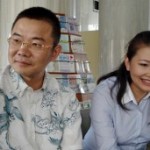
June 11, 2011 Ryukyu Shimpo
Tripod is a company operating out of Tomigusuku City that mainly coordinates healthcare tourism. Its president, Seishu Tamaki, is seeking to collaborate with Yuanhua Healthcare Co.Ltd, headed by president Zhao Lei, to attract wealthy tourists from China. With 500,000 members, Shanghai-based company Yuanhua Healthcare Co.Ltd is a leading provider of medical advice services in China, offering medical insurance to rich clients.
On his first visit Okinawa, on June 9 president Zhao visited the healthcare facilities of Tomigusuku accompanied by Tamaki.
“Okinawa has a well-established medical environment, and people are well taken care of here. I think that there is great potential in terms of customer service. I am confident that even wealthy people from China will enjoy it here,” Zhao said on June 10, indicating his interest in a partnership with the Okinawan company.
To date, Tripod has invited six people from Beijing and Taiwan for a tour in which they had cancer screening and medical check-ups at Toyosaki Clinic and Tomishiro Chuo Hospital, but it is yet to establish any alliances with foreign companies. “We aim to establish links with a counterpart in China in August. Business possibilities for Okinawa will be enhanced when our alliance is put in place,” said Tripod bureau chief Katsuya Maezato hopefully.
That same day, Zhao exchanged views with Deputy Governor Yoshiyuki Uehara at the Prefectural Office. Uehara commented, “Okinawa already has visitors who come here for a short time for physical examinations, but we hope to extend available services to include medical resorts for long-stay care in the future. As another highlight of Okinawan tourism, we will strive to create a well-organized system in this sector.”
Zhao also visited Tomigusuku City, which promotes medical tourism. Mayor Haruki Gibo welcomed the visitors from China, expressing his proactive approach by saying, “China is a significant market for us. We intend to actively work to attract people from China.”
(English Translation by T&CT, Mark Ealey)
Go To Japanese
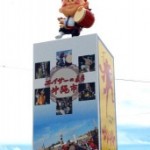
June 14, 2011, Ryukyu Shimpo
Okinawa Zento (all islands) Eisa Festival Executive Committee (headed by Mitsuko Tomon, Mayor of Okinawa City) has erected a tower advertising Eisa, a type of folk dance unique to the people of the Ryukyu Islands, at the Raikamu (Rycom) intersection in Yamazato, Okinawa City.
Celebrating the fourth anniversary of Okinawa City proclaiming itself to be “The City of Eisa” on June 13, 2007, the city held a ceremony to announce the completion of the tower on June 13, 2011. The tower has a logo and pictures of Eisa on it. The character “Eibou (Tentative)” smiles down at pedestrians and passing cars and passes on information about Okinawa City being “The center of Eisa.”
Okinawa City plans to build such towers around the Okinawa Expressway Okinawa City South Interchange in 2012 and at the Goya Crossroads in 2013.
To commemorate the fourth anniversary of the declaration of “The City of Eisa,” the Okinawa City Assembly, chaired by Hiroshi Nakasone, read out the declaration statement prior to opening their June regular meeting on June 13.
Okinawa City Mayor Tomon said, “As the Okinawa Zento Eisa Festival approaches, various events such as Eisa nights will be held around the city. Thanks to the hard work of our residents, we have succeeded in building this tower, which will warmly welcome visitors to our city.”
(English Translation by T&CT, Mark Ealey)
Go To Japanese
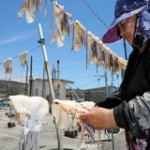
June 11, 2011 by Yasuhide Matayoshi, Photographer of Ryukyu Shimpo
A typical scene as people start their traditional summer work of drying squid in the sun on the fishermen’s island of Ojima, Nanjo City. Squid caught in the morning are carefully prepared and brought into the port to be hung out to dry on lengths of barbed wire.
The white squid glisten in the bright sunshine and sway in the sea breeze. “This year we have caught large squid even though we have just started fishing,” said Teruko Chinen, 71 year-old owner of a fish shop near the port.
Fishing for squid reaches its peak in August and continues until October.
(English Translation by T&CT, Mark Ealey)
Go To Japanese
Go To Video
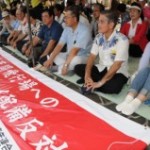
June 13, 2011 Ryukyu Shimpo
On the morning of June 13 residents of Ginowan City watched a sit-in protest rally at the City Hall against plans to deploy the MV-22 Osprey vertical takeoff and landing transport aircraft. The protest included Takeshi Asato, mayor of Ginowan City, city council members and members of six major groups from the city. The U.S. military plans to deploy the aircraft at the Futenma Air Station in Ginowan City from late 2012.
Before the protest action, Mayor Asato said, “Fifteen years have passed since the governments of Japan and the United States agreed that the Futenma Air Station should be returned to the people of Okinawa, but there has been no progress at all in that direction. Residents of Ginowan are plagued by incessant noise, and the U.S. military does not keep to the terms of the noise control agreement that prohibits the operation of helicopters after 10:00pm. Helicopters blatantly fly over residential areas flouting limitations placed on their flight course. This is outrageous, so there is no way that we can allow the deployment of the Osprey.”
(English Translation by T&CT, Mark Ealey)
Go To Japanese
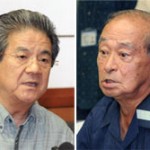
June 14, 2011 Ryukyu Shimpo
On June 13, Defense Minister Toshimi Kitazawa met Okinawa Governor Hirokazu Nakaima at the prefectural office to formally tell him that the governments of the United States and Japan will decide to build a V-shape runway for the replacement facilities for the U.S. Marine Corps Futenma Air Station, at Henoko, Nago City, at the US-Japan Security Consultative Committee for defense ministers and foreign ministers (2 + 2) scheduled to be held on June 21.
The governor repeatedly asked the defense minister to relocate the Futenma Air Station out of Okinawa and indicated his dissatisfaction with the policy of Tokyo and Washington, saying, “If both governments do decide on this plan it will not proceed without the consent of the residents. This is indeed unfortunate and regrettable.”
A sit-in protest against the Osprey vertical takeoff and landing deployment plan to Futenma by residents, including Ginowan City Mayor Takeshi Asato was held. People’s opposition to government policy is growing within the prefecture.
Meanwhile, in the United States, the Chairman of the Senate Committee on Armed Services Carl Levin and other leading lawmakers judged it to be “unrealistic,” to relocate the facilities and functions of Futenma to Henoko, and proposed the merger of Futenma and Kadena Air Base. Former CIA chief Leon Panetta, who will become the new Secretary of Defense, is reported to be flexible with regard to reviewing the “Futenma-to-Henoko” plan.
Negative opinion regarding this plan has started to appear in the United States and the governments of the two nations clearly lack the ability to convince the Okinawan people and the U.S. Congress.
The governor told the defense minister, “The basic premise of this discussion is that the facilities at Futenma should be moved as soon as possible and that residents be released from the dangerous situation they currently find themselves in. I think that the relocation of the air station to another prefecture is the quickest option.”
In response, with regard to the deployment of the MV-22 Osprey to Futenma, Kitazawa explained, “The risks and technical difficulties with the aircraft are resolved.” Nakaima replied by saying, “Accidents involving this aircraft are still clear in my memory. I cannot agree with the offer that you will bring to those living in the middle of our city,” and continued, “You are trying to do something akin to putting them in Hibiya Park in Tokyo.”
With regard to the deadline of “2014” that both governments agreed to in the Futenma relocation plan, the defense minister said, “It is difficult to complete in practice,” and “We are concerned that the facilities Futenma may become immovable, so we need to make arrangements in order to achieve the plan as soon as possible.”
With regard to measures to reduce the burden on Okinawa, Kitazawa referred to the discussion of a partial deactivation of the “Hotel-Hotel” training area off the northeastern coast of the main island of Okinawa, saying, “We are negotiating with the United States for a full return.”
(English Translation by T&CT, Mark Ealey)
Go To Japanese
June 11, 2011 Ryukyu Shimpo
A survey conducted by Ryukyu Shimpo on June 10 about the deployment of MV-22 Osprey vertical take-off and landing transport aircraft at the Futenma Air Station from 2012 has revealed that this is opposed by the heads of 38 of 48 municipalities in the prefecture.
Ryukyu Shimpo received responses from all the heads of the municipalities in the prefecture except that of Ginoza Village who could not be reached due to being away on a business trip to South America.
Those opposed to the deployment pointed out the issue of noise and the increased risk, and some also expressed strong feelings of distrust towards the Japanese government. It is clear that there is concern in Okinawa about the safety of the Osprey due to the fact that there were significant failures during flight-testing in its developmental stage and one subsequent combat-zone crash.
Ryukyu Shimpo conducted the survey on June 9 and 10.
Takeshi Asato, the mayor of Ginowan City, which hosts the Futenma Air Station said, “In a situation in which local residents and the people of Okinawa are already forced to live with the risks of crashes and the impact of noise, we cannot tolerate any further strengthening of the base’s function and imposing an even greater strain on the prefecture.”
Susumu Inamine, the mayor of Nago City – where the Japanese and the U.S. governments have agreed that the Futenma Air Station is to be relocated – said, “The deployment of the Osprey is dangerous and will increase noise levels. Increasing the burden on Okinawa cannot be tolerated. Neither the governor nor the residents of the prefecture will accept such a plan.”
With regard to the fact that the Japanese government said nothing about the deployment of Osprey until the announcement by the U.S. Department of Defense on June 6, many people were critical, saying, “The Japanese government has intentionally avoided making an announcement.”
There is also a demand for the disclosure of accurate information regarding issues such as safety.
Many heads of municipalities are clearly concerned about increased risk due to the deployment of Osprey at Futenma Air Station and request that an environmental impact assessment be conducted on the assumption that Osprey aircraft will be deployed at the Futenma Air Station.
Takeshi Onaga, Mayor of Naha City, who is also head of the Okinawa Association of City Mayors, affirmed his position on no need for an environmental impact assessment, but also said, “The deployment of the Osprey at Futenma Air Station flies in the face of the idea of reducing the burden on Okinawa of the U.S. military bases. I am absolutely opposed to it.”
Mayor of Miyakojima City abstained from voting, saying “The deployment of the Osprey at the Futenma Air Station would not directly affect us.”
Head of Tarama Village answered, saying, “I cannot comment on the issue due to a lack of information and knowledge.”
(English Translation by T&CT, Mark Ealey)
Go To Japanese
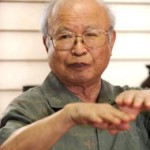
June 9, 2011, Ryukyu Shimpo,
Eighty-five year-old Tatsuhiro Oshiro, an Akutagawa Prize-winning writer, will publish his anthology of short stories Futenma yo through Shinchosha Co., Ltd. in mid-June. Futenma yo, is the overarching name of seven short stories written specifically for this publication.
The piece squarely addresses the problems surrounding the Futenma Air Station, such as the constant roar of planes over Ginowan City, the crash of a U.S. military helicopter at Okinawa International University, and the relocation of Futenma Air Station to Henoko, Nago City.
Oshiro said, “The protests of the Okinawan people are intrinsically linked to their memory of what was their land. The Futenma issue goes back to the identity of the Okinawan people who seek the return of the land that was taken from them by the U.S. military.”
His previous anthology of short stories is made up of pieces written using the motif of the war, with titles such as Natsukusa yo and Genei no Yukue.
His new work, Futenma yo, is set in Aragusuku, Ginowan City, which borders on Futenma Air Station. The plot develops around the memories of old settlements taken over by the U.S. military bases.
The protagonist’s grandmother confesses him her desire to enter Futenma Air Station in order to dig up the remains of the old settlement to try to find her tortoise-shell comb that had been in the family for generations. While his parents are bewildered by the grandmother’s stubborn determination, the protagonist tries to fulfill her wish.
The story is full of scenes in which U.S. airplanes suddenly roar through the sky.
His grandmother gets the protagonist’s family to understand the irrational fact that the U.S. military have taken over land that the family had inherited from its ancestors, and that U.S. aircraft rule once safe skies. Through the eyes of three generations, the story highlights the struggle against the U.S. military bases in the daily lives of the people of Okinawa.
With regard to the Futenma issue, Oshiro commented, “The grandmother’s desire to regain the land taken by the U.S. military is unremitting. The Japanese government may try to pull the wool over the eyes of the Okinawan people, but the locals’ attitude towards the bases is indomitable. The protests will continue.”
(English Translation by T&CT, Mark Ealey)
Go To Japanese
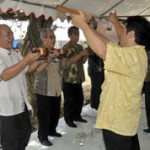
June 8, 2011 Ryukyu Shimpo
On June 6 and 7, the harvest festival Sutsuupunaka was held in four sites in Tarama Village with all the villagers wishing for a year with a good harvest.
From late in the evening on June 6 into the early hours of June 7, elders sang divine songs and villagers conducted akatsukinigai, in which they pass around libation offerings in square plates and saucers known as yunaus.
From around noon to the evening of June 7, six tsukasa, or women who administers the ritual, and invited guests such as Masaaki Shimoji, visited the four ceremony sites: Nagashiga, Fudaya, Piejuni and Areeki, where they drank libation and wished for a year of good harvest with the vocal accompaniment of the villagers, “Yunatoorega, yuitoorega, heeya, yakka, yakka, yakka.”
Along with the “August Dance (8-gatsu odori),” Sutsuupunaka is one of Tarama Village’s traditional feature events. It was designated as an intangible folk cultural asset for the village in 1983.
Based on their roles, groups called za are formed for each of the four ceremony sites: the rojin-za or churou-za for the elders, the kanjin-za which oversees the running of the ritual, the busha-za which makes and serves libation, the imu-za which catches fish for offerings, and the kuban-za which cooks the food.
Twenty-seven year-old Kakuei Toguchi, who joined the busha-za in Piejuni this year, said, “It was a lot of fun, but at the same time was really hard. I would like to learn the correct way of doing it in order to pass it on to our juniors in future.”
(English Translation by T&CT, Mark Ealey)
Go To Japanese

June 7, 2011 Ryukyu Shimpo
The diving team Snack Snufkin has found traces of dugong eating seaweed underwater about 600 meters off the coast south of Sedake, Nago City.
Nobu Nishihara, a representative of the team that carried out the biological survey in Oura Bay, said, “This sort of thing has often been observed off the coast of Henoko and Abe at the mouth of the Oura Bay, but it might be the first time that such traces of seaweed eaten by dugong have been found further out in the bay.”
They found marks in water about five meters deep off the coast of Nodake, where the dugongs’ favorite snack, umihirumo seaweed, grows. This is an area in which seaweed is not as plentiful as off the shore of Abe or other places. The trail left by dugong grazing on the seaweed was about 10 meters long, and it is clear from those marks that the dugong ate there between June 4 and 5.
“We wonder how they could find feeding sites deeper out in the bay. This is important in terms of understanding how dugongs live, which is not something we know much about. But, it is also testimony to the abundance of nature in Oura Bay,” said Nishihira.
The Snufkin team will carry out further investigation on June 9.
(English Translation by T&CT, Mark Ealey)
Go To Japanese
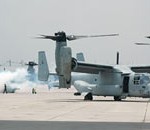
June 7, 2011 Ryukyu Shimpo
On June 6, the Okinawa Defense Bureau (ODB) officially notified the prefectural government and relevant municipalities of Ginowan City, Nago City and Kin Town that the U.S. Marine Corps will deploy MV-22 Osprey vertical takeoff and landing transport aircraft at the Futenma Air Station from 2012.
It has been confirmed that the Marine Corps will conduct daily familiarization training flights for Osprey crew in northern area of Okinawa.
In the past, the Japanese government has avoided giving notification of the deployment of the Osprey, which the governor of Okinawa, Hirokazu Nakaima, is known to oppose.
The Osprey is planned to replace the CH-46 Sea Knight helicopters, and it is claimed that in comparison with the Sea Knight the noise from the Osprey is greater during take-off and landing, which will inevitably attract strong protest within the prefecture.
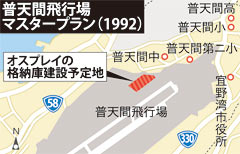
“Master Plan for Marine Corps Air Station Futenma”
The ODB explained to the prefectural government and the municipalities that the U.S. government had contacted the Japanese Ministry of Defense regarding the deployment of the MV-22, saying, “No final decision has been made regarding the exact deployment schedule, but the MV-22 is likely to replace the CH-46 Sea Knight helicopters of III Marine Expeditionary Force currently deployed at Futenma from the end of 2012.”
On this basis, the ODB said, “We will discuss the notification process regarding the deployment of the MV-22 at Futenma Air Station in the context of the Japan-U.S. alliance.”
The prefectural government asked the ODB about the Japanese government’s position on the deployment, but as of June 6, the ODB had not responded.
The ODB gave notification of the deployment of the MV-22 to Futenma Air Station to municipalities such as Nago City, to which the facilities currently at Futenma may be relocated, Kin Town, which hosts Camp Hansen, and Higashi Village, which hosts the Jungle Warfare Training Center. It seems that the ODB assumes that the MV-22 will carry out training flights to those U.S. military bases.
The deployment could result in changes, such as increases in the level of noise around Futenma Air Station.
In 1992, in its “Master Plan for Marine Corps Air Station Futenma,” the U.S. Department of the Navy clearly indicated its intention to locate the base for the MV-22 in the northwest section of the Futenma Air Station.
The Marine Corps announced in autumn 2010 that two squadrons of MV-22 Ospreys would replace 24 CH-46 Sea Knight helicopters in two lots, in October 2012 followed by October 2013.
There has been continued concern in Okinawa regarding the safety of Osprey because in its developmental stage there were significant failures during flight-testing and one combat-zone crash since.
It is also pointed out that in comparison with the CH-46, the noise from the Osprey increases during hovering, takeoff and landing and that it requires more training hours for the pilot to get used to its operation, something which will in turn also increase the overall noise level.
(English Translation by T&CT, Mark Ealey)
Go To Japanese










 Webcam(Kokusai Street)
Webcam(Kokusai Street)


